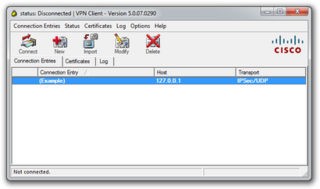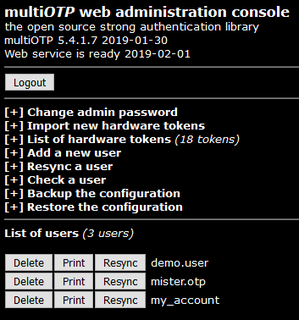Related Research Articles

In computing, BIOS is firmware used to perform hardware initialization during the booting process, and to provide runtime services for operating systems and programs. The BIOS firmware comes pre-installed on a personal computer's system board, and it is the first software to run when powered on. The name originates from the Basic Input/Output System used in the CP/M operating system in 1975. The BIOS originally proprietary to the IBM PC has been reverse engineered by some companies looking to create compatible systems. The interface of that original system serves as a de facto standard.

Wake-on-LAN (WoL) is an Ethernet or Token Ring computer networking standard that allows a computer to be turned on or awakened by a network message.
A network switch is networking hardware that connects devices on a computer network by using packet switching to receive and forward data to the destination device.
A network operating system (NOS) is a specialized operating system for a network device such as a router, switch or firewall.
Simple Network Management Protocol (SNMP) is an Internet Standard protocol for collecting and organizing information about managed devices on IP networks and for modifying that information to change device behavior. Devices that typically support SNMP include cable modems, routers, switches, servers, workstations, printers, and more.
In computing, iSCSI is an acronym for Internet Small Computer Systems Interface, an Internet Protocol (IP)-based storage networking standard for linking data storage facilities. It provides block-level access to storage devices by carrying SCSI commands over a TCP/IP network. iSCSI is used to facilitate data transfers over intranets and to manage storage over long distances. It can be used to transmit data over local area networks (LANs), wide area networks (WANs), or the Internet and can enable location-independent data storage and retrieval.
Cisco Internetwork Operating System (IOS) is a family of network operating systems used on many Cisco Systems routers and current Cisco network switches. Earlier, Cisco switches ran CatOS. IOS is a package of routing, switching, internetworking and telecommunications functions integrated into a multitasking operating system. Although the IOS code base includes a cooperative multitasking kernel, most IOS features have been ported to other kernels such as QNX and Linux for use in Cisco products.

Internet Information Services is an extensible web server software created by Microsoft for use with the Windows NT family. IIS supports HTTP, HTTP/2, HTTPS, FTP, FTPS, SMTP and NNTP. It has been an integral part of the Windows NT family since Windows NT 4.0, though it may be absent from some editions, and is not active by default.
Cisco PIX was a popular IP firewall and network address translation (NAT) appliance. It was one of the first products in this market segment.
ifconfig is a system administration utility in Unix-like operating systems for network interface configuration.
Cracking a wireless network is defeating the security of a wireless local-area network. A commonly used wireless LAN is a Wi-Fi network. Wireless LANs have inherent security weaknesses from which wired networks are exempt.
In systems management, out-of-band management involves the use of management interfaces for managing and networking equipment.
Kickstart is the bootstrap firmware of the Amiga computers developed by Commodore International. Its purpose is to initialize the Amiga hardware and core components of AmigaOS and then attempt to boot from a bootable volume, such as a floppy disk. Most Amiga models were shipped with the Kickstart firmware stored on ROM chips.

Cisco Systems VPN Client is a software application for connecting to virtual private networks based on Internet Key Exchange version 1.

In computing, Linux-IO (LIO) Target is an open-source implementation of the SCSI target that has become the standard one included in the Linux kernel. Internally, LIO does not initiate sessions, but instead provides one or more Logical Unit Numbers (LUNs), waits for SCSI commands from a SCSI initiator, and performs required input/output data transfers. LIO supports common storage fabrics, including FCoE, Fibre Channel, IEEE 1394, iSCSI, iSCSI Extensions for RDMA (iSER), SCSI RDMA Protocol (SRP) and USB. It is included in most Linux distributions; native support for LIO in QEMU/KVM, libvirt, and OpenStack makes LIO also a storage option for cloud deployments.
In computer networking, Cisco ASA 5500 Series Adaptive Security Appliances, or simply Cisco ASA, is Cisco's line of network security devices introduced in May 2005, that succeeded three existing lines of popular Cisco products:
DNOS or Dell Networking Operating System is a network operating system running on switches from Dell Networking. It is derived from either the PowerConnect OS or Force10 OS/FTOS and will be made available for the 10G and faster Dell Networking S-series switches, the Z-series 40G core switches and DNOS6 is available for the N-series switches.
AlliedWare Plus is a fully featured Layer 3 operating system developed by Allied Telesis, used on its high-end enterprise network switches, and is the successor to AlliedWare. It is a package encompassing CLI and GUI management, routing, switching and internetworking functionality into a multitasking operating system for IPv4 and IPv6 Ethernet networks. It offers many standards-based features and protocols along with some proprietary technologies such as VCStack for highly resilient stacking solutions, EPSRing for resilient ring topologies, AMF for simplified network management, and Active Fiber Monitoring for secure fiber links.

multiOTP is an open source PHP class, a command line tool and a web interface that can be used to provide an operating system independent strong authentication system. multiOTP is OATH certified since version 4.1.0 and is developed under the LGPL license. Starting with version 4.3.2.5, multiOTP open source is also available as a virtual appliance - as a standard OVA file, a customized OVA file with open-vm-tools, and also as an Hyper-V downloadable file.
Mirai is a malware that turns networked devices running Linux into remotely controlled bots that can be used as part of a botnet in large-scale network attacks. It primarily targets online consumer devices such as IP cameras and home routers. The Mirai botnet was first found in August 2016 by MalwareMustDie, a white hat malware research group, and has been used in some of the largest and most disruptive distributed denial of service (DDoS) attacks, including an attack on 20 September 2016 on computer security journalist Brian Krebs' web site, an attack on French web host OVH, and the October 2016 Dyn cyberattack. According to a chat log between Anna-senpai and Robert Coelho, Mirai was named after the 2011 TV anime series Mirai Nikki.
References
- ↑ Tseng, Mickey. "ZyNOS General FAQ". Zyxeltech.de. Retrieved 2014-03-07.
- ↑ "Timeline". Archived from the original on 2012-05-31. Retrieved 2012-06-06.
- ↑ "ZYXEL LAUNCHES IPv6 UPGRADE FOR BUSINESS SECURITY GATEWAYS AND ETHERNET SWITCHES". Archived from the original on 2012-05-12. Retrieved 2012-06-06.
- 1 2 "ZyBook2.book" (PDF). Retrieved 2014-03-07.
- ↑ "Ethernet Switch Reference Guide V3.90 (Nov 2008)" (PDF). Retrieved 2014-03-07.
- ↑ Tseng, Mickey. "ZyNOS CI Command List". Zyxeltech.de. Retrieved 2014-03-07.
- ↑ ftp://ftp2.zyxel.com/GS2200-24P/user_guide/GS2200-24P_4.00_ed1.pdf
- ↑ Nasro (2014-01-11). "How I saved your a** from the ZynOS (rom-0) attack !! ( Full disclosure )". root@Nasro. Retrieved 2019-08-18.
- ↑ "ZyNOS ROM-0 DECODER".
- ↑ Soo, Jacob (2015-05-12), GitHub - jacobsoo/ROM0_Decoder: Rom0 Decoder. , retrieved 2019-08-18
- ↑ "ZyXEL ZyNOS 4.x". Secunia. Retrieved 2014-03-07.
- ↑ "ZyXEL ZyNOS 3.x". Secunia. Retrieved 2014-03-07.
- ↑ "DNS hijacking flaw affects D-Link DSL router, possibly other devices". Lucian Constantin. Retrieved 2015-01-30.